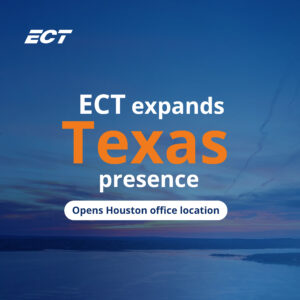In July 2025, a wave of new federal actions altered the review and approval process for wind and solar projects across the U.S., which have introduced likely delays, uncertainty, and risk. ECT’s experts have analyzed these developments and outlined key takeaways to help you stay on track. Facing delays or need guidance navigating these shifts? Contact us for strategic support.
Continue reading for a full breakdown of the changes and implications from Associate Market Leader, Renewable Energy, Rebecca Powell and Senior Practice Leader, Ryan Blankenship, CWB®.
Core Mandate: A New Layer of Political Review
These series of executive orders and departmental memoranda create a standardized federal approval process for the renewable energy market by establishing a new, highly centralized review system for wind and solar projects.
- Fulfilling an Executive Order (EO): The July 15, 2025 DOI memorandum is a direct implementation of Executive Order 14315 (“Ending Market Distorting Subsidies for Unreliable, Foreign- Controlled Energy Sources”), issued on July 7, 2025. That EO explicitly directed the Secretary of the Interior to review and revise policies to eliminate any “preferential treatment” for wind and solar facilities.
- Mandatory Upper-Level Review: The U.S. Department of the Interior (DOI) memorandum states that “all decisions, actions, consultations, and other undertakings” related to wind and solar facilities will now be required to pass through “multiple layers” of upper-level review within the department.
- Secretarial Sign-Off: This new process culminates in requiring final review by Interior Secretary Doug Burgum for projects on federal land and 69 additional federal authorizations or approvals.
- Politicizing the Process: This directive effectively removes final authority from career staff at agencies like the Bureau of Land Management, National Park Service, Bureau of Indian Affairs, Bureau of Reclamation, and U.S. Fish and Wildlife Service and places it directly within the office of a political appointee.
Unprecedented Scope and Reach
The power of these orders lies in their exceptionally broad scope and currently unpredictable review timelines.
- 69 Targeted Activities: The heightened scrutiny applies to 69 distinct activities across the entire project lifecycle. This includes not just final permits but also preliminary steps such as:
- National Environmental Policy Act (NEPA) reviews, Environmental Assessments (EA), Environmental Impact Statements (EIS), Findings of No Significant Impact (FONSI), and Records of Decision (ROD).
- A multitude of real estate transactions including 1) right-of-way applications, grants, leases, and transfers, 2) lease sales, assignments, and issuances, 3) temporary use permits, 4) access road authorizations, 5) utility corridor concurrences, and 6) decommissioning applications.
- Consultations regarding the Endangered Species Act, Migratory Bird Treaty Act, and Bald and Golden Eagle Protection Act.
- Section 106 of the National Historic Preservation Act.
- Grants and other actions requiring Federal Register Notices.
- Beyond Federal Lands: Because many projects on state and private lands require some form of federal consultation (e.g., for a Clean Water Act permit or Federal Aviation Administration (FAA) filing), the order’s reach extends across jurisdictional lines, giving federal regulatory agencies leverage over the U.S. renewable energy sector.
Strategic Context and Intent
The July 15, 2025, DOI memorandum is the tactical implementation of the broader agenda to curtail renewable energy development.
- Some Actions Currently Unaffected if not for Interagency Reviews: Permit authorizations pursuant to FAA requirements, Section 10 of the Rivers and Harbors Act, and Section 401/404/408 of the Clean Water Act (CWA) are not specifically cited in the EOs and subsequent memoranda as requiring DOI review; however, when initiated, these actions include requirements for interagency review which are specifically cited as one or more of the 69 actions requiring DOI review. The energy industry can anticipate complicating factors with the federal review of FAA, CWA, and other federal nexus triggers in portions of the nation where these requirements have not been delegated to state authorities. Other agency actions such as Jurisdictional Determinations (JDs) are review actions which are not specifically tied to project development types. Therefore, it is ECT’s direct experience that these JDs may continue without elevated review. ECT received U.S. Army Corps of Engineers issued JDs on July 16 and July 18, 2025.
- Lacks Context for Implementation: Based on ECT phone inquiries with the USFWS in July 2025, the DOI memorandum lacks context for Regional or local Ecological Service Field Office (ESFO) implementation. Lacking guidance, these local offices are instructing staff to issue a temporary stay on the processing of wind and solar energy development projects until further national guidance is issued. This national guidance is anticipated in the coming weeks. Currently, local USFWS staff are unsure how to coordinate efforts with DOI and when those project specific reviews are required. In light of this uncertainty, USFWS moved to update their Information for the Planning and Consultation (IPaC) portal on July 18, 2025, to state that the resource is no longer available to process solar and wind energy projects. Additionally, species specific determination keys have been updated to exclude consideration of solar and wind energy projects.
- Creating a Permitting Purgatory: The July 15, 2025, DOI memorandum introduces an administrative bottleneck that lacks transparency and results in unpredictable delays within the permitting process. These challenges may undermine the financial viability of projects, particularly for developers striving to meet the stringent timelines required for clean energy tax credits under the “One Big Beautiful Bill Act.” As the investment and production tax credits supporting renewable energy development sunset under OBBBA, the reduced timeframe for claiming these credits, coupled with ongoing regulatory permitting complexities, substantially affects the feasibility of numerous projects currently under development.
Implications for the U.S. Energy Sector
- Delays should be Anticipated: The new review process is expected to slow, stall, or block approvals for new wind and solar projects. In the short term, the temporary stay that USFWS has placed on processing solar and wind energy projects is problematic for Section 7 of the Endangered Species Act consultation requirements and requires further consideration for advancing Section 9/10 actions for previously available Incidental Take Permit (ITP) provisions under voluntary Habitat Conservation Plans (HCP). Interagency coordination requirements may have ripple effects to otherwise lawful actions outside the purview of the DOI (e.g., for a CWA permit administered by the U.S. Army Corps of Engineers or FAA filing).
- Future Schedules Uncertain: Based on phone conversations between ECT and the USFWS in July 2025, the agency is uncertain of any regulatory framework or anticipated timeline that may be anticipated with the DOI mandate for sign-off approval. The local ESFOs are also unsure of when USFWS Headquarters may lift the temporary stay on project reviews by issuance of a national guidance document.
- Strategies on Advancing Projects: Based on phone conversations between ECT and federal agencies in July 2025, the agencies recommend that solar and wind energy generation projects continue to use long-standing best management practices, previously issued agency guidance, and regulatory planning tools (like IPaC and the species-specific determination keys) to evaluate resource constraints and advance considerations for wind and solar energy development. Additionally, it is recommended that projects attempt to not trigger federal authorizations requiring interagency coordination (i.e., CWA Authorization) by siting projects in portions of the nation either devoid of federal lands and/or utilizing state delegated authorizations rather than federal authorizations. Many regulations allow non-federal project proponents to “self-certify” their project activities if the non-federal project sponsor can adequately demonstrate that project activities will avoid or have otherwise minor or discountable impacts to protected environmental resources. The use of “self-certifying” authorizations may remove the requirements of these orders and subsequent memoranda for DOI approval. Issuance of Technical Assistance Letters, ITPs, and HCPs by the USFWS offer optional protections afforded under Section 9/10 provisions of the Endangered Species Act. Since these actions are not currently advancing, the USFWS contacts recommended to ECT via phone conversations in July 2025, to send notice of project advancement to the agency for project development milestones (including Wind Energy Guidelines for Tier I, II, and III surveys) but to not anticipate agency response or acknowledgement until further DOI guidance is issued. In the absence of agency approvals and processing, it is ECT’s recommendation for project proponents to continue to develop projects under self-certifying provisions according to best available science and previous precedent.
The federal actions referenced and issued by various departments in July of 2025 include:
- Executive Order (EO) 14315, entitled “Ending Market Distorting Subsidies for Unreliable, Foreign-Controlled Energy Sources”
- EO 14156, entitled “Declaring a National Energy Emergency”
- Presidential Memorandum, entitled “Temporary Withdrawal of All Areas on the Outer Continental Shelf from Offshore Wind Leasing and Review of the Federal Government’s Leasing and Permitting Practices for Wind Projects”
- Secretary’s Order (SO) 3417, entitled “Addressing the National Energy Emergency”
- SO 3418, entitled “Unleashing American Energy”
- Department of the Interior, July 15, 2025, Memorandum, entitled “Departmental Review Procedures for Decisions, Actions, Consultations, and Other Undertakings Related to Wind and Solar Energy Facilities”




